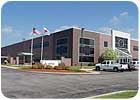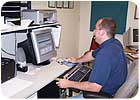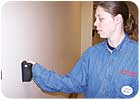
The West Henrietta, N.Y., facility of the American Red Cross is designed with three rings of security.
Managers at the main facility of American Red Cross Blood Services in the New York-Pennsylvania region in 2004 evaluated the facility’s existing proprietary security system and found it to be outdated and unfriendly.
Upgrades and enhancements were expensive, and improvements and obtaining new products always took longer than scheduled. Frustrating regulatory issues existed when getting the system to communicate with other facilities and to reside properly on a centralized server.
Every drop of blood collected by the Red Cross in upstate New York and the Wilkes-Barre and Scranton area of northeastern Pennsylvania is transported to the main facility in West Henrietta, N.Y., a suburb of Rochester. The facility also serves as the headquarters for the New York-Penn Region.
“There were several challenges that we faced in this project,” reveals Chuck Schramm, sales engineer for West Fire Systems Inc., Rochester, N.Y. “The first was that the American Red Cross had systems already in place.
“We had to ‘live swap’ systems one at a time, one door at a time,” he relates. “We needed to make sure that we did not leave any potential for security issues while converting over to the new system.

Andy Luft, service manager for West Fire Systems Inc., Rochester, N.Y., performs routine maintenance on the access control database server in the security office at the West Henrietta location of the American Red Cross.
Adds Mike Meath, Red Cross regional facilities manager, “We wanted open, compatible architecture. We’re highly regulated as a technical pharmaceutical manufacturing site by the FDA [Food and Drug Administration], our national headquarters in Washington D.C. and our own in-house quality assurance department. We wanted the system to control access, give full reporting and be user-friendly to staff.”
Schramm emphasizes that the system’s adaptability already has been tested. “We have already seen changes that were needed due to the impact of the Homeland Security Act, including special monitoring of specific equipment that the Red Cross uses,” he notes. “This equipment did not need any special security monitoring before and only changed as a result of the growth of the Homeland Security Act.”
Five Red Cross sites throughout New York state needed to be connected via a centralized server. The Buffalo facility has 30 card readers, West Henrietta has 35, Syracuse has 30, Binghamton has 10 and Albany has eight.
“One of the obstacles to integrating a couple of different systems at different sites was the proprietary cards in use at that time,” Schramm relates. “We needed a system with the capability of reusing the existing card databases from more than one source.”
The Symmetry professional security management system from AMAG Technology Inc., Torrance, Calif., was installed in the Buffalo, N.Y., building to meet the job’s needs. The security management system and databases are controlled at the West Henrietta site.
Views from surveillance video cameras can be pulled up in real time to monitor events. Cameras are set to record constantly throughout the day and on an event basis after hours. Events include motion, card swipe and alarms.
Security is designed in rings around the perimeter of the building. The first level of security is entrance to the general office area and mail room, which requires a card swipe. The second level of security is the large, temperature-controlled manufacturing area where blood products are delivered, processed and distributed.

Kate Sundloft, administrative assistant 2 for general services of the America Red Cross, demonstrates use of the thumb print reader at the West Henrietta, N.Y., facility.
“We store tremendous amounts of personal information and health histories collected from our donors, so high security is paramount,” Meath notes.
The highest level of security is inside the lab where production of blood products occurs. Authorized employees use a card swipe and keypad with anti-passback features to enter this area, in addition to having already passed through three layers of security.
A biometric reader is used as a time clock for evening cleaning crew members. “Installing a biometric reader in the janitorial closet maintains the integrity of the night cleaning crew,” explains Schramm. “Using the biometric reader makes each cleaning person present their thumb when they report to work – that way the Red Cross only pays those reporting for work.”
Meath’s office workstation controls 400,000 square feet of buildings, and all security systems communicate via the Internet.
“We measure our success in the day-to-day running of our business,” Meath declares. “To our employees, it is definitely easier to get a badge or have an access level changed, and we can audit the system on a regular basis. We do it faster and more efficiently than before.”
Adds Schramm, “Conversion time was cut in half of what we expected it to take thanks to the ease of the system. Fortunately, because of our and AMAG’s forward thinking, we were able to easily accommodate all of the Red Cross’ needs to date.”
Sidebar: PROJECTS in the News
Rocky Mountain Metropolitan Airport, Colorado’s fourth busiest airport, uses ACS WebServiceBrivo Systems LLC, Bethesda, Md., to ensure full access control to the aircraft operating area.Protection Onewon the contract for installation and maintenance. At any one time, the Brivo system manages more than 2,300 active security cards being utilized by airport and related personnel as well as service providers to airport businesses. Panels are installed at all 13 airport gates. Eleven of the gates are controlled by the wireless (cellular) version of the control panel, and two of them are controlled by IP-based controllers. The system is programmed to provide redundant alerts in the event of gate failures to staff, as well as the 24-hour agent-on-duty’s cell phone.â– â– â–
WZ18 All-Weather Integrated Day-Night cameras fromExtreme CCTV Inc., Burnaby, British Columbia, will provide video footage of some of the most endangered and elusive cats in the world for the Wildlife Conservation Network. The footage will enable WCN conservationists and scientists to better understand the snow leopard, Andean mountain cat and Chinese desert cat, each among the world’s rarest felines. The cameras will be installed at locations in the alpine and sub-alpine mountains of central Asia, the inhospitable deserts of the Andes and the sub-zero temperatures of the Tibetan highlands.
â– â– â–
The MESH system, RFID access readers and voice communication systems fromViscount Systems Inc., Burnaby, British Columbia, are being installed in seven buildings in Ontario, Canada. The initial order is for approximately $50,000. “Up until this point, most MESH shipments have been for new construction projects which were booked up to three years ago," noted Stephen Pineau, president and CEO.